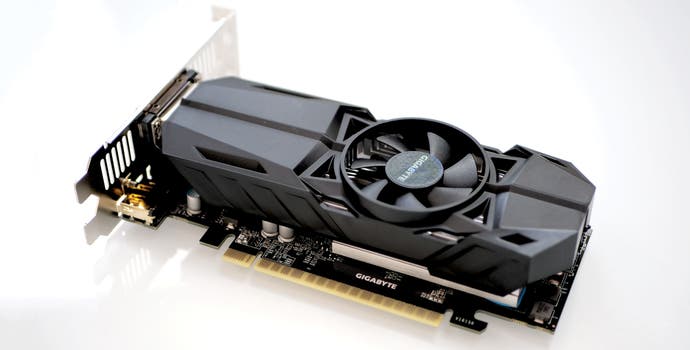Nvidia GeForce GTX 1050 3GB review: the best budget graphics card?
A cut-back design offers up surprisingly decent performance.
Snuck out a few weeks back, the GeForce GTX 1050 3GB has been met with some degree of bafflement and bewilderment from the PC hardware press, but choose the right model - like the Gigabyte example reviewed here - and you have the best entry-level budget GPU on the market. As things stand, our only major criticism of the vanilla GTX 1050 is its meagre 2GB of framebuffer memory - not enough for console-quality textures on many games. This revised model beefs up processing power and adds that crucial extra gig of RAM, but it comes with a sting in the tail - memory bandwidth drops significantly, meaning a performance penalty in some games.
It's a curious situation but the bottom line is that the GP107 processor used in both 1050 and 1050 Ti comes equipped with a 128-bit memory interface - good for 2GB and 4GB VRAM configurations but incompatible with a 3GB set-up. The only way Nvidia can create this new model is by shaving the memory interface down to 96-bits, meaning a substantial 25 per cent hit to memory bandwidth - 112GB/s becomes a mere 84GB/s. By extension, ROP count is hit too - this is reduced to 24 instead of the usual 32. On paper, it looks like a fudge - a round peg forced through a square hole, especially considering that lower-end GPUs can use all the memory bandwidth they can get.
Thinking about upgrading your gaming PC? Take a look at our recommendations for the best graphics cards on the market. Pairing your graphics card with one of the best gaming monitors is also important, so check out our latest picks!
Nvidia's solution to the potentially crippling performance hit? The GTX 1050 3GB comes with the full complement of CUDA cores found in the top-end GTX 1050 Ti, meaning 768 of them up against the cut-back 640 in the vanilla two gig version of the same card. This is backed by a higher boost clock, meaning that Nvidia is attempting to mitigate the bandwidth cutbacks by brute-forcing higher performance through sheer compute alone. Almost inevitably then, in-game frame-rates vs other GP107 cards will depend very much on how much they rely on compute power or memory bandwidth. The benchmarks later on will reveal all.

| The GP107 Stack | GPU Cores | Boost Clock | TFLOPS | Memory | Memory Bandwidth |
|---|---|---|---|---|---|
| GTX 1050 2GB | 640 | 1455MHz | 1.8 | 2GB GDDR5 | 112GB/s |
| GTX 1050 3GB | 768 | 1518MHz | 2.3 | 3GB GDDR5 | 84GB/s |
| GTX 1050 Ti | 768 | 1392MHz | 2.1 | 4GB GDDR5 | 112GB/s |
- Note: official boost clock specs don't reflect actual performance that closely - all GP107 products seem to operate between 1700Hz up to around 1785MHz, depending on load
But before we get address game performance directly, I've got to say that I'm rather taken with the Gigabyte rendition of the card reviewed here. It's like a stubbier, fatter version of the bargain basement GT 1030. It boosts to a max of around 1785MHz, it doesn't require any PCI Express power inputs and it comes with a DVI port, DisplayPort and dual HDMIs - some might even say it's over-equipped in terms of outputs. In operation it's almost completely silent, and it's also a half-height card supplied with an optional bracket, meaning it's good for small form factor PCs too. As a Pascal card, it comes with an excellent media encode/decode block - so good it's good for HTPC duties.

As much as I like it though, there are limits. Don't go into this one expecting to be able to overclock your way to much in the way of improved performance. The lack of PCI Express power input means that while you can overclock the core, actual increases to GPU clocks won't deliver much in the way of improved in-game frame-rates. Additionally, in something of a first, MSI Afterburner refused to overclock the GDDR5 memory at all - I just got a white screen and a return to the desktop after a slightly worrying pause. In effect, what you see is what you get with this card and there's nothing in the way of meaningful 'free' performance to tap into, or any way to mitigate the cut-back memory bandwidth situation. Mileage may vary on any GTX 1030 3GB you may purchase, mind you, but that's the lay of the land with mine..
And that's the thing, really - the choice of model is really important. Not many GTX 1050 3GB models have made it to the market at the moment, and of those that have, prices have been just a touch too close to the existing - and undoubtedly better - GTX 1050 Ti. The Gigabyte model we chose is under £130 and in fact, just a few pounds more than the 2GB model from the same company. The sense I get is that this new product will essentially replace the vanilla version in the fullness of time and while there are minor performances issues in some titles, by and large, it is the better product.
So with all of this in mind, let's dive into some games to see how Nvidia's somewhat unusual configuration holds up. Can GTX 1050 Ti levels of compute still deliver decent performance when paired with a mere 84GB/s of memory bandwidth? We're about to find out.
Nvidia GeForce GTX 1050 3GB Analysis:

